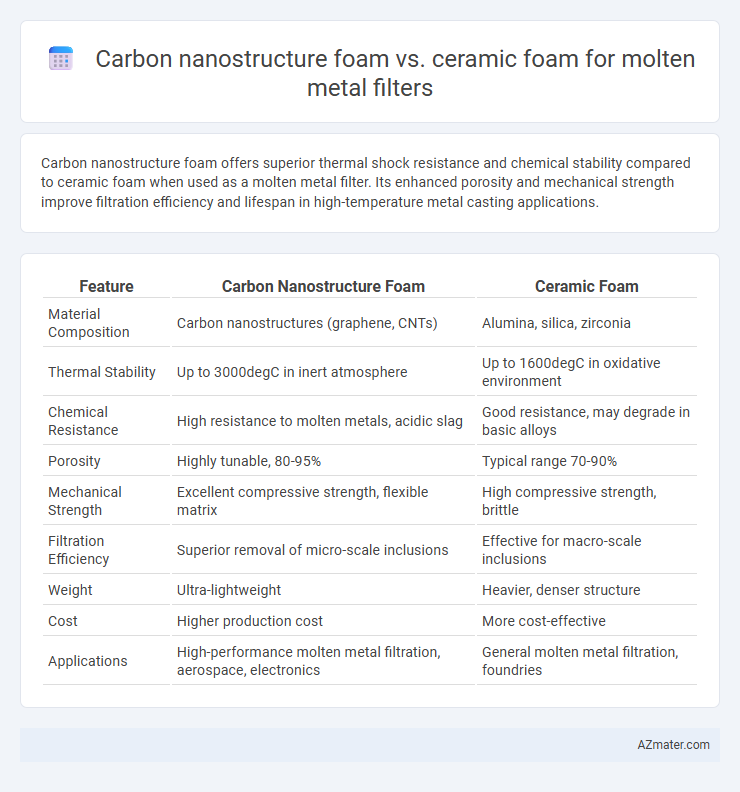Carbon nanostructure foam offers superior thermal shock resistance and chemical stability compared to ceramic foam when used as a molten metal filter. Its enhanced porosity and mechanical strength improve filtration efficiency and lifespan in high-temperature metal casting applications.
Table of Comparison
| Feature | Carbon Nanostructure Foam | Ceramic Foam |
|---|---|---|
| Material Composition | Carbon nanostructures (graphene, CNTs) | Alumina, silica, zirconia |
| Thermal Stability | Up to 3000degC in inert atmosphere | Up to 1600degC in oxidative environment |
| Chemical Resistance | High resistance to molten metals, acidic slag | Good resistance, may degrade in basic alloys |
| Porosity | Highly tunable, 80-95% | Typical range 70-90% |
| Mechanical Strength | Excellent compressive strength, flexible matrix | High compressive strength, brittle |
| Filtration Efficiency | Superior removal of micro-scale inclusions | Effective for macro-scale inclusions |
| Weight | Ultra-lightweight | Heavier, denser structure |
| Cost | Higher production cost | More cost-effective |
| Applications | High-performance molten metal filtration, aerospace, electronics | General molten metal filtration, foundries |
Introduction to Molten Metal Filtration
Molten metal filtration is crucial for improving metal quality by removing non-metallic inclusions and impurities during casting processes. Carbon nanostructure foam offers superior thermal shock resistance and chemical stability compared to traditional ceramic foam, enabling longer service life and enhanced filtration efficiency in high-temperature environments. Ceramic foams, while cost-effective and widely used, often suffer from lower durability and reduced filtration precision under extreme thermal cycling conditions.
Overview of Carbon Nanostructure Foam
Carbon nanostructure foam exhibits exceptional thermal stability and chemical resistance, making it a superior choice for molten metal filtration compared to traditional ceramic foam. Its high porosity and interconnected nanostructures enable efficient slag entrapment while maintaining minimal pressure drop during filtration. The foam's robustness against thermal shock and corrosive environments extends its operational lifespan, enhancing overall process efficiency in metallurgical applications.
Overview of Ceramic Foam
Ceramic foam filters, made from materials such as alumina, silicon carbide, or zirconia, offer high thermal stability and excellent chemical resistance for molten metal filtration. Their interconnected porous structure enables efficient removal of non-metallic inclusions, improving metal quality and reducing defects. The high melting point and mechanical strength of ceramic foams make them suitable for repeated use in casting processes involving molten metals like aluminum, steel, and copper.
Filtration Efficiency: Carbon vs Ceramic Foams
Carbon nanostructure foam exhibits superior filtration efficiency in molten metal applications due to its ultra-fine pore size and high surface area, effectively capturing microscopic inclusions and impurities compared to ceramic foam. The interconnected nanoporous network in carbon foam enhances particle entrapment and reduces clogging, leading to prolonged filter lifespan and consistent metal flow. Ceramic foams, while thermally stable and corrosion-resistant, generally possess larger pore sizes that limit their ability to filter ultra-fine particles, resulting in lower overall filtration performance.
Thermal Stability and Resistance Comparison
Carbon nanostructure foam exhibits superior thermal stability up to 3000degC in inert atmospheres, making it highly resistant to thermal degradation during molten metal filtration. Ceramic foam typically withstands temperatures around 1600degC to 1800degC but is more prone to thermal shock and structural brittleness under rapid temperature fluctuations. The resistance of carbon nanostructure foam to oxidation and chemical attack in molten metal environments outperforms ceramic foam, which can degrade or crack in harsh oxidative conditions.
Mechanical Strength and Durability
Carbon nanostructure foam exhibits superior mechanical strength and durability compared to traditional ceramic foam when used as molten metal filters, due to its exceptional tensile strength and resistance to thermal shock. The inherent resilience of carbon nanostructures allows for prolonged filter life and reduced risk of cracking or deformation under extreme temperatures and repeated thermal cycling. Ceramic foams, while effective in filtration, often suffer from brittleness and lower fracture toughness, limiting their durability in high-stress molten metal environments.
Chemical Compatibility with Molten Metals
Carbon nanostructure foam exhibits superior chemical compatibility with molten metals such as aluminum, copper, and steel, resisting oxidation and corrosion even at high temperatures above 1600degC. Ceramic foam, typically made from alumina or silicon carbide, shows excellent stability and resistance to chemical attack but can suffer from brittleness and degradation in highly reducing or carbon-rich environments. Carbon nanostructure foam's inertness and thermal shock resistance make it preferable for aggressive metallurgical filtration processes where maintaining purity and structural integrity is critical.
Pore Structure and Permeability Analysis
Carbon nanostructure foam exhibits a highly interconnected porous network with nanoscale pore sizes, significantly enhancing its permeability and filtration efficiency for molten metal applications. In contrast, ceramic foam typically features larger, more irregular pores, resulting in lower permeability but higher thermal and chemical stability under extreme temperatures. The optimized pore structure of carbon nanostructure foam allows superior control over molten metal flow rates, reducing inclusions and improving metal purity compared to ceramic foam filters.
Cost and Manufacturing Considerations
Carbon nanostructure foam offers lower material costs and simpler manufacturing processes compared to ceramic foam, making it more economical for molten metal filtration applications. Its lightweight nature and higher thermal conductivity contribute to reduced energy consumption during production, further driving down expenses. In contrast, ceramic foam requires higher sintering temperatures and longer processing times, leading to increased manufacturing complexity and overall cost.
Future Prospects in Molten Metal Filtration Technologies
Carbon nanostructure foam offers enhanced thermal stability, superior chemical resistance, and improved mechanical strength compared to traditional ceramic foam, making it a promising material for future molten metal filtration applications. Advances in nano-engineering enable carbon-based foams to achieve higher filtration efficiency and longer service life by reducing clogging and maintaining pore integrity at elevated temperatures. Emerging research into hybrid composites combining carbon nanostructure foams with ceramic elements suggests significant potential for optimizing filtration performance and cost-effectiveness in next-generation molten metal filtration technologies.

Infographic: Carbon nanostructure foam vs Ceramic foam for Molten metal filter
 azmater.com
azmater.com